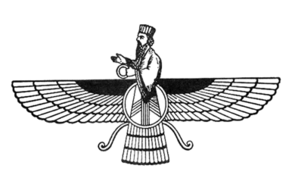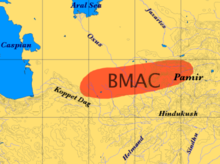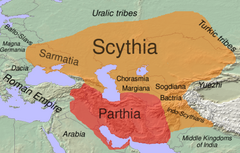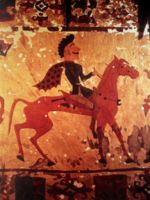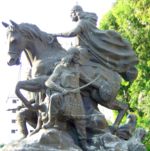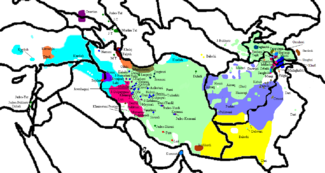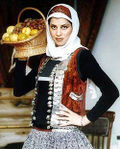Iranian peoples
2007 Schools Wikipedia Selection. Related subjects: Peoples
|
Iranian peoples
|
|
|---|---|
 |
|
| Total population | 152.7 - 205.2 million (estimates vary) |
| Regions with significant populations | Middle East, South Asia, Central Asia, Caucasus, and also dispersed across the world due to immigration |
| Language | Iranian languages |
| Religion | Predominately Muslim. Also some Christianity, Judaism, Zoroastrianism, Atheism, Bahá'í Faith, and varius others |
The Iranian peoples are a collection of ethnic groups defined by their usage of Iranian languages and discernable descent from ancient Iranian peoples. The Iranian peoples live chiefly in the Middle East, Central Asia, the Caucasus, and parts of the Indian subcontinent, though speakers of Iranian languages were once found throughout Eurasia, from the Balkans to western China. As Iranian peoples are not confined to the borders of the current state of Iran, the term Iranic peoples is sometimes used as an alternative in order to avoid confusion with the citizens of modern Iran.
The series of ethnic groups which comprise the Iranian peoples are traced to a branch of the ancient Indo-European Aryans known as the Iranians or Proto-Iranians. Some scant information about the way of life of these early people has been elucidated through archaeological finds in Russia, Central Asia and the Middle East. The Iranian peoples have played an important role throughout history: the Achaemenid Persians established the world's first multi-national state, and the Scythian- Sarmatian nomads dominated the vast expanses of Russia and western Siberia for centuries and gave birth to the infamous Amazons. In addition, the various religions of the Iranian peoples, including Zoroastrianism and Manichaeism, were important early philosophical influences on Judeo-Christianity. Early Iranian tribes were the precursors to many diverse modern peoples, including the Persians, the Kurds, the Pashtuns, and many other, smaller groups. The southern Iranian peoples survived Alexander the Great's conquests, Muslim Arab attempts at cultural dominance, and devastating assaults by the Mongols, whereas the Iranians of the north were largely assimilated by the Slavs and other European peoples.
Etymology and usage
The term Iranian is derived from Iran (lit: "Land of the Aryans"). The old Proto-Indo-Iranian term Arya, meaning "noble", is believed to have been one of a series of self-referential terms used by the Aryans, at least in the areas populated by Aryans who migrated south from Central Asia and southern Russia. Their ancient homeland was referred to as Airyanem Vaejah and varied in its geographic range, sometimes referring to Fars (according to Eratosthenes), sometimes to the area around Herat ( Pliny's view), sometimes to the entire expanse of the Iranian plateau ( Strabo's designation).
From a linguistic standpoint, the term Iranian peoples is similar in its usage to the term Germanic peoples, which includes various peoples who happen to speak Germanic languages such as German, English and Dutch, or the term Slavic peoples, which includes various speakers of Slavic languages including Russians, Bosniaks, and Serbs. Thus, along similar lines, the Iranian peoples include not only the Persians, or Tajiks, of Iran, Afghanistan and Tajikistan, but also the Pashtuns, Kurds, Ossetians, Baloch, and a number of other groups. The academic usage of the term Iranian peoples, or Iranic peoples, is thus distinct from the state of Iran and its various citizens (who are all Iranian by nationality, and thus popularly referred to as Iranians), in the same way that Germanic peoples is distinct from Germans. Many citizens of Iran are not necessarily "Iranian peoples", by virtue of not being speakers of Iranian languages, and may not have discernable ties to ancient Iranian tribes.
History and settlement
- See also: History of Central Asia, History of the Middle East, History of Iran, History of the Kurds, History of Afghanistan, History of Tajikistan, History of Uzbekistan, History of Turkmenistan, History of Pakistan, History of India, and History of Azerbaijan
Roots
Having descended from the Aryans (Proto- Indo-Iranians), the ancient Iranian peoples separated from the Indo-Aryans, Nuristanis and Dards in the early 2nd millennium BCE. The Iranian languages form a sub-branch of the Indo-Iranian sub-family, which is a branch of the family of Indo-European languages. The Iranian peoples stem from early Proto-Iranians, themselves a branch of the Indo-Iranians, who are believed to have originated in either Central Asia or Afghanistan circa 1800 BCE. The Proto-Iranians are traced to the Bactria-Margiana Archaeological Complex, a Bronze Age culture of Central Asia. The area between northern Afghanistan and the Aral Sea is hypothesized to have been the region where the Proto-Iranians first emerged, following the separation of Indo-Iranians tribes.
By the first millennium BCE, Ancient Iranian peoples such as the Medes, Persians, Bactrians and Parthians populated the Iranian plateau, while Iranian peoples such as the Scythians, Sarmatians, and Alans populated the steppes north of the Black Sea. The Saka and Scythian tribes remained mainly in the north, and spread as far west as the Balkans and as far east as Xinjiang. Later offshoots, related to the Scythians, included the Sarmatians, who vanished following Slavic and other invasions into southern Russia, the Ukraine, and the Balkans, presumably due to having been assimilated by other tribes.
There are only scant references to these early Proto-Iranian invaders in the early writings of the ancient Assyrians and Babylonians. Two of the early offshoots of the Proto-Iranians are known: Avestan speakers in Afghanistan, and Old Persian speakers in Fars in southeastern Iran. The Avestan texts known as the Gathas are believed to have been written by Zoroaster, the founder of Zoroastrianism, while Old Persian appears to have been established in written form following the adoption of cuneiform from the Sumerians. The Yaz culture (ca. 1500-1100 BC) may mark the development of Eastern Iranian and the emergence of Avestan culture.
The first mentioning by an Iranian tribe of their "Aryan" lineage is from an early inscription known as the Behistun Inscription, recording a proclamation by Darius I of Persia that he was of Aryan ancestry and that his language was an Aryan language. The inscription thus provides a link in the Iranian languages to the usage of the term Arya in early Indo-Aryan texts. These ancient Persians recognized three official languages ( Elamite, Babylonian, and Old Persian), which suggests a multicultural society. It is not known to what extent other Proto-Iranian tribes referred to themselves as "Aryan", or if the term has the same meaning in other Old Iranian languages.
Western Iranians
The ancient Persians established themselves in the western portion of the Iranian plateau, and appear to have interacted considerably with the Elamites and Babylonians, while the Medes also intermingled with local Semitic peoples to the west. Remnants of the Median language and Old Persian show their common Proto-Iranian roots, emphasized in Strabo and Herodotus' analyses of their languages, which they believed to be very similar to the languages spoken by the Bactrians and Soghdians in the east. Following the establishment of the Achaemenid Empire, the Persian language spread from Fars to various regions of the empire, with the modern dialects of Iran, Afghanistan (also known as Dari) and Central-Asia (known as Tajiki) descending from Old Persian.
The Avestans' main impact was religious and liturgical, as the early inhabitants of the Persian Empire appear to have adopted the religion of Zoroastrianism. The other prominent Iranian peoples, such as the Kurds, are surmised to stem from Iranic populations that mixed with Caucasian peoples such as the Hurrians, due to some unique qualities found in the Kurdish language that mirror those found in Caucasian languages. The Baloch relate an oral tradition regarding their migration from Aleppo, Syria around the year 1000 CE, whereas linguistic evidence links Balochi to Kurdish and Zazaki.
Eastern Iranians
While the Iranian tribes of the south are better known through their modern counterparts, the tribes which remained largely in the vast Eurasian expanse are known through the references made to them by the ancient Greeks and Persians, as well as by archaeological finds. In the 5th century BCE, Herodotus made references to a nomadic people whom he identifies as the Scythians and describes as having dwelt in what is today southern Russia.
It is believed that these Scythians were conquered by their eastern cousins, the Sarmatians, who are mentioned by Strabo as the dominant tribe which controlled the southern Russian steppe by the 1st millennium CE. These Sarmatians were also known to the Romans, who conquered the western tribes in the Balkans and sent Sarmatian conscripts, as part of Roman legions, as far west as Roman Britain. Some tribes of Sarmatians are also identified as the Amazons of Greek legend, warrior women believed to have lived in a matrilineal society in which both men and women took part in war, and whose existence has been supported by recently-uncovered archaeological and genetic evidence.
The Sarmatians of the east became the Alans, who also ventured far and wide, with a branch ending up in Western Europe and North Africa, as they accompanied the Germanic Vandals during their migrations. The modern Ossetians are believed to be the sole direct descendants of the Alans, as other remnants of the Alans disappeared following Germanic, Hunnic, and ultimately Slavic invasions.
Some of the Saka-Scythian tribes in Central Asia would later move further south and invade the Iranian plateau and northwestern India (see Indo-Scythians). Another Iranian tribe related to the Saka-Scythians were the Parni in Central Asia, a tribe that pressured, and ultimately overthrew, the rule of the Greek Seleucids in Persia. The Parni replaced the Seleucids as the Parthians, a dynasty that ruled Persia during the early centuries of the 1st millennium CE and became the main rival of the Roman Empire in the east. It is surmised that many Iranian tribes, including the Khwarezmians, Massagetae and Sogdians, were assimilated and/or pushed out of Central Asia by the migrations of Turkic tribes emanating out of Siberia.
The most dominant surviving Eastern Iranians are represented by the Pashtuns, whose origins are generally believed to be in southern Afghanistan, from which they began to spread until they reached as far west as Herat and as far east as the Indus. The Pashto language shows affinities to Bactrian, as both languages are believed to be of Middle Iranian origin. The modern Ossetians claim to be the descendants of the Alano-Sarmatians, and their claims are supported by their Northeast Iranian language, while culturally the Ossetians resemble their Caucasian neighbors, the Kabardians, Circassians and Georgians. Various extinct Iranian peoples existed in the eastern Caucasus, including the Azaris, while some Iranian peoples remain in the region, including the Talysh and the Tats (including the Judeo-Tats, who have relocated to Israel), found in Azerbaijan and as far north as the Russian republic of Dagestan.
Later developments
In ancient times, the majority of southern Iranian peoples became adherents of Zoroastrianism, Buddhism (in parts of Afghanistan and Central Asia), Judaism and Nestorian Christianity (largely amongst the Kurds and Persians living in Iraq). The Ossetians would later adopt Christianity as well, with Russian Orthodoxy becoming dominant following their annexation into the Russian Empire, while some converted to Islam due to the influence of the Ottomans.
Starting with the reign of Omar in 634 CE, Muslim Arabs began a conquest of the Iranian plateau. The Arabs conquered the Sassanid Empire of the Persians and seized much of the Byzantine Empire populated by the Kurds and others. Ultimately, the various Iranian peoples, including the Persians, Kurds and Pashtuns, were converted to Islam. The Iranian peoples would later split along sectarian lines as the Persians (and later the Hazara) adopted the Shi'a sect, while the majority of other Iranian peoples remained adherents of Sunni Islam. As ancient tribes and identities changed, so did the Iranian peoples, many of whom assimilated foreign cultures and peoples.
Later, during the 2nd millennium CE, the Iranian peoples would play a prominent role during the age of Islamic expansion and empire. Saladin, a noted adversary of the Crusaders, was an ethnic Kurd, while various empires centered in Iran (including the Safavids) re-established a modern dialect of Persian as the official language spoken throughout much of what is today Iran and adjacent parts of Central Asia. Iranian influence spread to the Ottoman Empire, where Persian was often spoken at court, as well as in the Mughal Empire, which began in Afghanistan and shifted to India. All of the major Iranian peoples reasserted their use of Iranian languages following the decline of Arab rule, but would not begin to form modern national identities until the 19th and early 20th centuries (just as Germans and Italians were beginning to formulate national identities of their own).
Demographics
There are an estimated 150 million native speakers of Iranian languages. Currently, most of these Iranian peoples live in Iran, Afghanistan, Tajikistan, western-Pakistan, parts of Uzbekistan (especially Samarkand and Bukhara), the Caucasus ( Ossetia and Azerbaijan), and the Kurdish areas (referred to as Kurdistan) of Turkey, Iraq, Iran and Syria. Smaller groups of Iranian peoples can also be found in western China, India and Israel.
Due to recent migrations, there are also large communities of speakers of Iranian languages in Europe and the Americas.
Diversity
It is largely through linguistic similarities that the Iranian peoples have been linked, as many non-Iranian peoples have adopted Iranian languages and cultures. However, other common traits have been identified as well, and a stream of common historical events have often linked the southern Iranian peoples, including Hellenistic conquests, the various empires based in Persia, Arab Caliphates, and Turkic invasions.
Although most of the Iranian peoples settled in the Iranian plateau region, many expanded into the periphery, ranging from the Caucasus and Turkey to the Indus and western China. The Iranian peoples have often mingled with other populations, with the notable example being the Hazaras, who display a distinct Turkic- Mongol background that contrasts with most other Iranian peoples. Similarly, the Baloch have mingled with the Dravidian-speaking Brahui (who have been strongly modified by Iranian invaders themselves), while the Ossetians have invariably mixed with Georgians and other Caucasian peoples. Moreover, the Kurds are an eclectic Iranian people who, although displaying some ethnolinguistic ties to other Iranian peoples (in particular their Iranian language, and some cultural traits), are believed to have mixed with Caucasian and Semitic peoples. Modern Persians themselves are also a heterogeneous group of peoples descended from various ancient Iranian and indigenous peoples of the Iranian plateau, including the Elamites. Thus, not unlike the aforementioned example of Germanic peoples including the English, who are both of Germanic and Celtic origin, Iranians are an ethno-linguistic group, and the Iranian peoples display varying degrees of common ancestry and cultural traits that denote their respective identities.
Culture and assimilation
Many of the cultural traits of the ancient Iranians were similar to other Proto-Indo-European societies. Like other Indo-Europeans, the early Iranians practiced ritual sacrifice, had a social hierarchy consisting of warriors, clerics, and farmers, and poetic hymns and sagas to recount their deeds.
Following the Iranian split from the Indo-Iranians, the Iranians developed an increasingly distinct culture. It is surmised that the early Iranians intermarried with and assimilated local cultures over a long period of time, and thus a caste identity was never needed or created by the Iranians—in sharp contrast with the Indo-Aryans.
Various common traits can be discerned amongst the Iranian peoples. For example, the social event Norouz is an Iranian festival that is practiced by nearly all of the Iranian peoples as well as others in the region. Its origins are traced to Zoroastrianism and pre-historic times.
Some Iranian peoples exhibit distinct traits that are unique unto themselves. The Pashtuns adhere to a code of honour and culture known as Pashtunwali, which has a similar counterpart amongst the Baloch, called Mayar, that is more hierarchical.
Religion
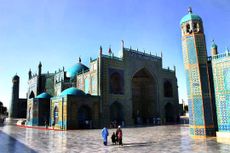
The early Iranian peoples may have worshipped various deities found throughout other cultures where Indo-European invaders established themselves. The earliest major religion of the Iranian peoples was Zoroastrianism, which spread to nearly all of the Iranian peoples living in the Iranian plateau.
Modern speakers of Iranian languages mainly follow Islam. Some follow Judaism, Christianity and the Bahá'í Faith, with an unknown number showing no religious affiliation. Of the Muslim Iranian peoples, the majority overall are followers of the Sunni sect of Islam, while most Persians and Hazaras are Shi'a. Shi'a Islam and Sufism in Iran are both thought to be affected by Persianism. The Christian community is largely represented by the Russian Orthodox denomination, followed by Ossetians and Nestorians. Judaism is followed mainly by Persian Jews, Jews of Afghanistan, Kurdish Jews, and Mountain Jews (of the Caucasus), most of which are now found in Israel. The historical religion of the Persian Empire was Zoroastrianism and it has some followers. They are known as the Parsis in India, or Zoroastrians in Iran and Pakistan.
Iranian influence upon Turkic peoples
In matters relating to culture, the various Turkic-speaking minorities of Iran (notably the Azerbaijani people) and Afghanistan ( Uzbeks and Turkmen) are often conversant in Iranian languages, in addition to their own Turkic languages, and also have Iranian culture to the extent that the term Turko-Iranian can be applied. The usage applies to various circumstances that involve historic interaction, intermarriage, cultural assimilation, bilingualism, and cultural overlap or commonalities.
Notable amongst this synthesis of Turko-Iranian culture are the Azeris, whose culture, religion, and significant periods of history are linked to the Persians. Certain theories and genetic tests suggest that the Azeris are descendants of ancient Iranian peoples who lost their Iranian language (see Ancient Azari language) following the Turkic invasions of Azerbaijan in the 11th century CE. In fact, throughout much of the expanse of Central Asia and the Middle East, Iranian and Turkic culture has merged in many cases to form various hybrid populations and cultures, as evident from various ruling dynasties such as the Ghaznavids, Saljuqs, and Mughals.
Iranian cultural influences have also been significant in Central Asia, where Turkic invaders are believed to have largely mixed with native Iranian peoples of which only the Tajik remain, in terms of language usage. The areas of the former Soviet Union adjacent to Iran, Afghanistan, and the Kurdish areas (such as Azerbaijan and Uzbekistan) have gone through the prism of decades of Russian and Soviet rule that has reshaped the Turko-Iranian cultures there to some degree.
Genetics
Genetic testing of Iranian peoples has revealed many common genes for most of the Iranian peoples, but with numerous exceptions and regional variations. Genetic studies conducted by Cavalli-Sforza have revealed that Iranians cluster closely with European groups and more distantly from Near Eastern groups. Some of the common genetic markers may stem from the ancient Proto-Iranians and parallel the spread of Iranian languages, which may have also been adopted through a process of assimilation by indigenous peoples and thus account for the diversity found amongst the Iranian peoples. Nonetheless, preliminary genetic tests suggest common origins for most of the Iranian peoples:
| Populations located west of the Indus basin, including those from Iran, Anatolia and the Caucasus, exhibit a common mtDNA lineage composition, consisting mainly of western Eurasian lineages, with a very limited contribution from South Asia and eastern Eurasia (fig. 1). Indeed, the different Iranian populations show a striking degree of homogeneity. This is revealed not only by the nonsignificant FST values and the PC plot (fig. 6) but also by the SAMOVA results, in which a significant genetic barrier separates populations west of Pakistan from those east and north of the Indus Valley (results not shown). These observations suggest either a common origin of modern Iranian populations and/or extensive levels of gene flow amongst them. |
Basically, the findings of this study reveal many common genetic markers found amongst the Iranian peoples from the Tigris to the areas west of the Indus. This correlates with the Iranian languages spoken from the Caucasus to Kurdish areas in the Zagros region and eastwards to western Pakistan and Tajikistan and parts of Uzbekistan in Central Asia. The extensive gene flow is perhaps an indication of the spread of Iranian-speaking peoples, whose languages are now spoken mainly upon the Iranian plateau and adjacent regions. These results relate the relationships of Iranian peoples with each other, while other comparative testing reveals some varied origins for Iranian peoples such as the Kurds, who show genetic ties to the Caucasus at considerably higher levels than any other Iranian peoples except the Ossetians, as well as links to Europe and Semitic populations that live in close proximity such as Jews and Arabs.
According to a recent study, the ancestors of the Kurds were from an old Mediterranean substratum, i.e. Hurrian and Hittite groups. According to this study the Aryan ancestry of the Kurds and other Iranian-speaking populations in Anatolia is not supported by genetic analyses.
Another recent study of the genetic landscape of Iran was completed by a team of Cambridge geneticists led by Dr. Maziar Ashrafian Bonab (an Iranian Azarbaijani). Bonab remarked that his group had done extensive DNA testing on different language groups, including Indo-European and non Indo-European speakers, in Iran. The study found that the Azerbaijanis of Iran do not have a similar FSt and other genetic markers found in Anatolian and European Turks. However, the genetic Fst and other genetic traits like MRca and mtDNA of Iranian Azeris were identical to Persians in Iran.
Ultimately, genetic tests reveal that while the Iranian peoples show numerous common genetic markers overall, there are also indications of interaction with other groups, regional variations, and cases of genetic drift. In addition, indigenous populations may have survived the waves of early Aryan invasions as cultural assimilation led to large-scale language replacement (as with some Kurds, Hazaras and others). Further testing will ultimately be required and may further elucidate the relationship of the Iranian peoples with each other and various neighboring populations.
List of Iranian peoples
Speakers of Iranian languages in modern times include:
- Bakhtiaris
- Baloch
- Gilanis
- Hazara
- Kurds
- Laks
- Lurs
- Mazanderanis ( Taberians)
- Ossetians
- Pashtuns
- Persians
-
- Tajiks
- Farsiwans
- Tats
- Irani
- Parsis
- Talyshi
- Wakhi
- Zazas
Note: Azeris are, due to historical ties with various ancient Iranians and their cultural ties with Persians, sometimes included as an Iranian people, although the modern Azerbaijani language is a Turkic language and the issue remains debated. (See Origin of Azerbaijani people and the Iranian Theory Regarding Azeri's for more details) The origin of South Slavic Serbs, Croats, and Bulgarians is sometimes also connected with Iranian peoples (see also: Theories on the origin of Serbs).
